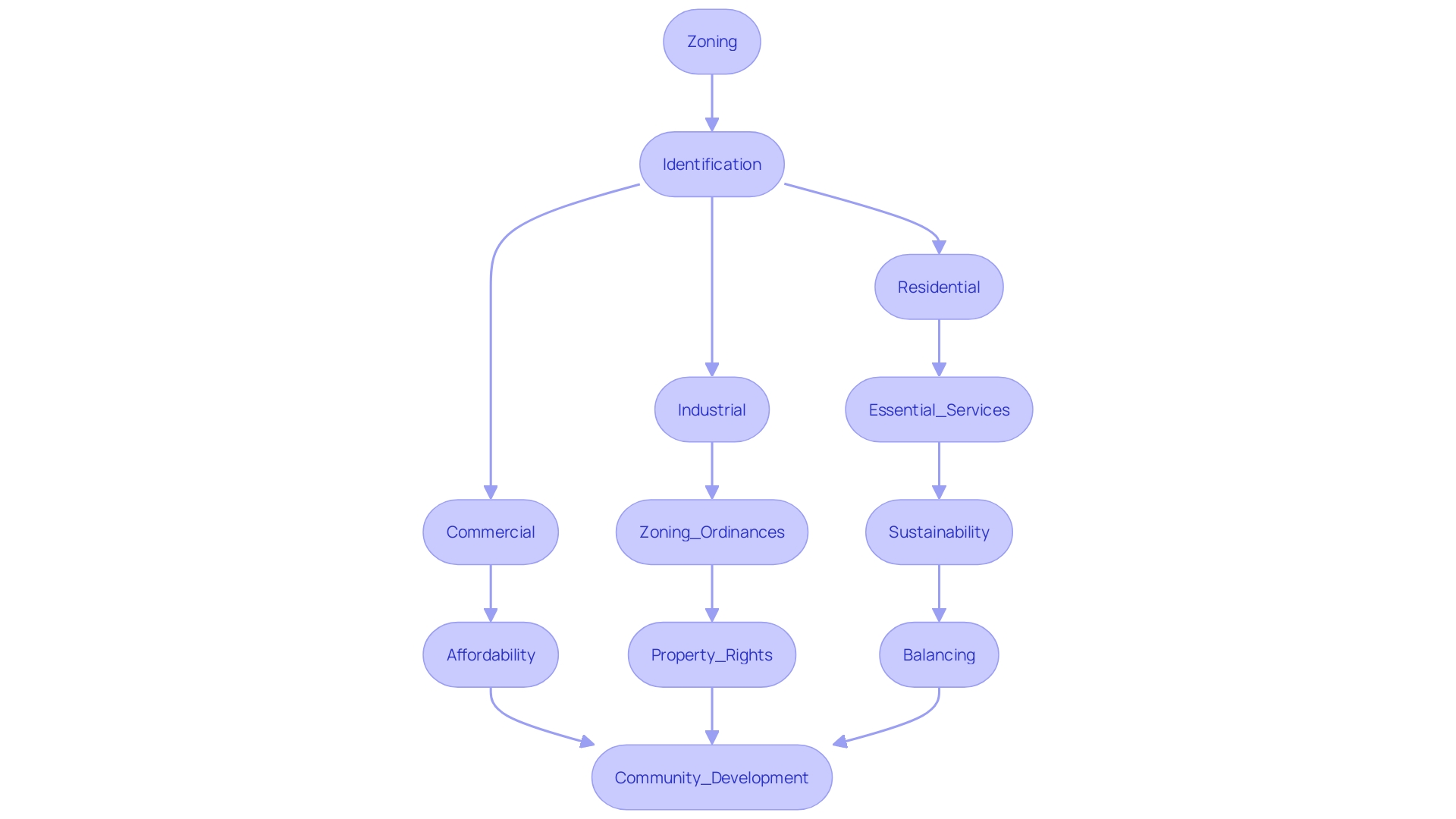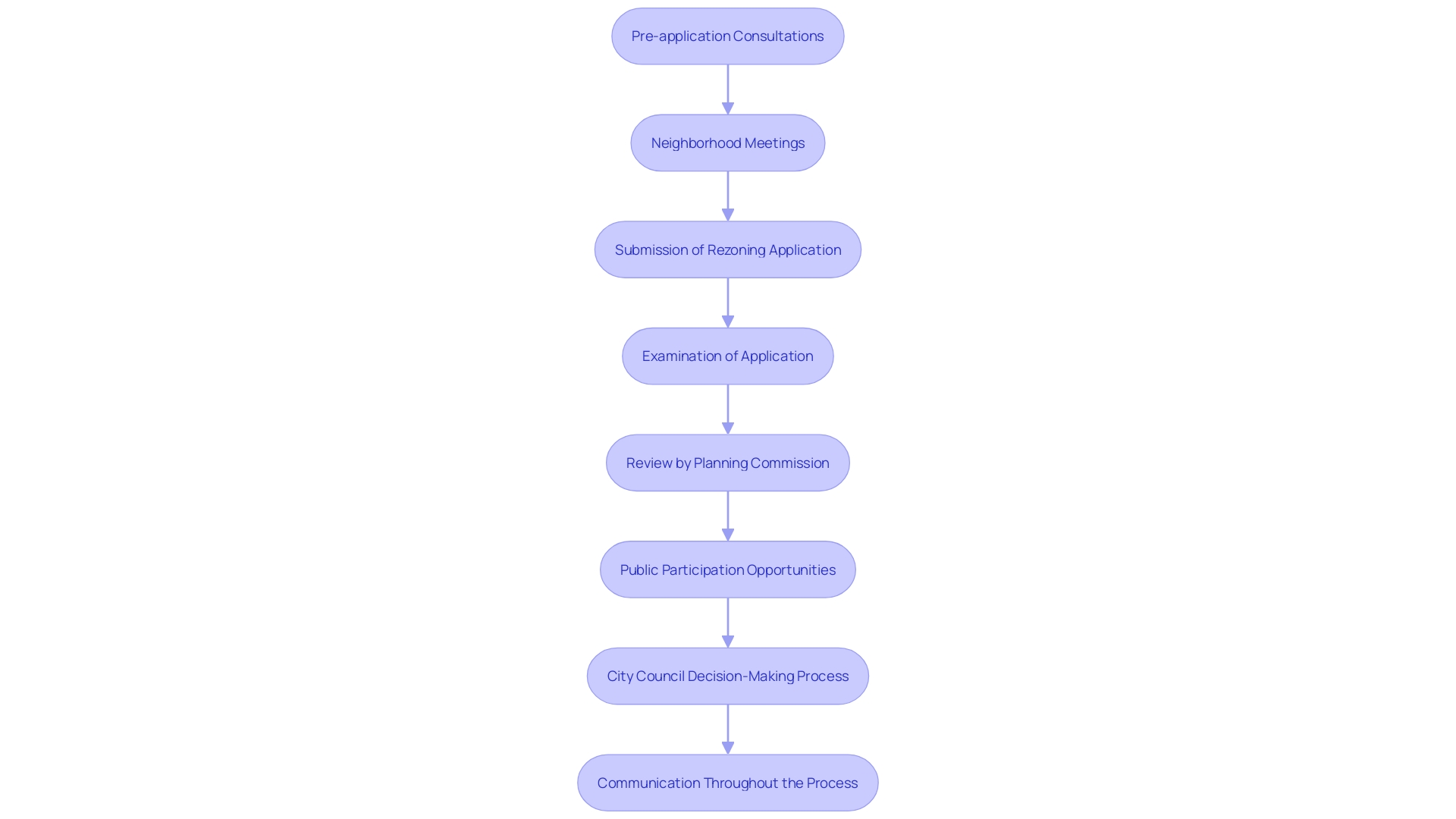Introduction
Local authorities establish zoning regulations to manage land development in a way that aligns with community objectives, ensuring organized land use. These regulations categorize land into zones such as residential, commercial, industrial, and agricultural. Each zone has specific permitted uses and restrictions, profoundly influencing community development and individual property rights.
The complexity and variety of zoning regulations across states, such as California, demonstrate the challenges and impact of zoning on residential development. Understanding the importance of zoning is crucial, as it shapes the framework of communities, preserves distinct character and quality, enhances public safety, and plays a pivotal role in environmental conservation. The rezoning process, which involves consultations, applications, and public participation, requires a deep understanding of property rights, legal frameworks, and clear communication.
By comprehending zoning regulations and the rezoning process, individuals involved in land development can navigate the complexities and make informed decisions to transform and utilize land in accordance with local governance and community aspirations.
Understanding Zoning Regulations
Local authorities establish zoning regulations to manage land development in a way that aligns with community objectives, ensuring organized land use. These regulations categorize land into zones such as residential, commercial, industrial, and agricultural. Each zone has specific permitted uses and restrictions, profoundly influencing community development and individual property rights.
Municipal zoning, while a tool for urban planning, can present challenges. For instance, in California's diverse landscape of 58 counties and 482 municipalities, extensive research has yielded zoning data for nearly all jurisdictions, demonstrating the complexity and variety of zoning regulations across the state. This data underscores how zoning can both restrict and enable residential development.
The case of Minneapolis exemplifies how zoning reform, driven by advocacy for housing affordability and inclusivity, can reshape urban landscapes. The city's passage of progressive zoning reforms, aimed at increasing housing density and affordability, illustrates the potential for zoning regulations to adapt to changing societal needs.
Furthermore, recent zoning code changes in St. Paul demonstrate a trend towards increasing neighborhood-scale density, continuing the conversation on zoning's impact on housing availability and urban development. These reforms highlight the evolving nature of zoning and its implications for cities across America.
Zoning is not merely a set of rules but a reflection of a community's vision for its future. It has the power to shape where people live, work, and engage with their surroundings. As such, it governs property usage rights and can significantly influence the daily lives of residents. The recognition of property rights as fundamental to individual liberty dates back to America's founding principles, underscoring the tension between governmental regulation and personal freedom.
Analyzing the evolution of zoning, from its origins to its current state, reveals its pervasive influence on property ownership and the utilization of land. This understanding is pivotal for anyone involved in land development, as it directly affects the ability to transform and utilize land in accordance with local governance and community aspirations.
Why Zoning is Important
Zoning profoundly shapes the framework of communities, serving as a tool to preserve the distinct character and quality of neighborhoods. By creating delineations between residential, industrial, and commercial zones, it safeguards homes from disruptive elements like noise and pollution. These regulations not only enhance public safety by designating suitable locations for essential services such as schools and hospitals but also play a pivotal role in environmental conservation. The strategic application of zoning laws directly impacts urban development, as observed in initiatives like the Cville Plans Together project in Charlottesville, which aims to foster residential density and affordability through revised zoning ordinances. Such efforts demonstrate a dynamic approach to zoning, adapting to emerging needs for more inclusive and sustainable urban planning. Furthermore, the evolution of zoning practices reflects a balancing act between the historical premise that property rights include unfettered usage and the contemporary need for structured urban growth. The implementation of form-based codes, as seen in Kingston, New York's 'Kingston 2025' comprehensive plan, exemplifies a modern strategy focused on physical form rather than segregation of uses. This shift underscores the importance of zoning as a key element in harmonizing the development of communities with the rights and aspirations of property owners.

How to Determine Current Zoning Designation
Identifying the current zoning status of a property is a fundamental step before pursuing a change to residential zoning. Local planning departments and zoning offices maintain comprehensive records, including zoning maps that detail the classifications for each land parcel. By engaging with these authorities, you can gain a thorough understanding of the applicable zoning standards and regulations. For instance, a zoning district might dictate a maximum building coverage of 40 percent, which includes all structures, detached or otherwise. The insights gleaned from consulting zoning authorities are invaluable in evaluating the feasibility of rezoning and determining the necessary procedures.
Zoning itself is a critical urban planning tool that governs land use and ensures orderly development. It's a complex system with various categories, each with its own specific implications for property owners, developers, and the community. This intricate tapestry of zones is designed to prevent new developments from disrupting existing ones, and at times, zoning can influence the availability of affordable housing.
Recent developments, such as Charlottesville's adoption of the Development Code in December 2023, highlight the dynamic nature of zoning laws. These changes reflect a broader trend towards increased residential density and development rights, demonstrating the government's role in shaping where we live, work, and play. As zoning regulations evolve, staying abreast of these changes is crucial for anyone involved in land development or investment.
In light of these considerations, it's evident that successful real estate investment hinges on a deep understanding of zoning regulations and their potential reforms. The case studies and legal challenges to zoning changes underscore the complexity of implementing such reforms. Thus, it's essential to approach zoning inquiries with a well-informed strategy, leveraging the expertise of seasoned professionals in real estate, land use, and development law.
The Rezoning Process
Understanding the rezoning process is pivotal for anyone seeking to change the designated use of a piece of land. Typically, the process begins with pre-application consultations and neighborhood meetings, designed to address any initial concerns and inform the community. The submission and examination of a rezoning application follow, where detailed plans and justifications for the land use change are presented to the relevant authorities.
Rezoning applications are not merely administrative; they are embedded within a complex legal framework. For instance, property rights are often considered in three dimensions, recognizing that rights to access air, sunlight, or even subterranean spaces can be restricted by law. These rights are clearly defined through statutory and common law, which have evolved over time to accommodate changing needs such as air travel and underground construction, without infringing on private property rights.
The nature of property itself is conceptually ambiguous, traditionally viewed as a bundle of rights and obligations conferred by the state. These rights are not absolute but are shaped by collective agreements and regulations that govern our interactions with the physical world. This is particularly relevant when considering airspace and subterranean rights, which are often excluded from private property entitlements and reserved for public use.
Once the application is submitted, it undergoes a rigorous review by the planning commission, during which the public can submit comments and participate in the decision-making process. This stage is crucial, as failure to provide input may forfeit the right to appeal decisions made by the city council. For example, recent public notices have indicated specific deadlines for submitting comments and have highlighted the importance of community engagement in the rezoning process.
The planning commission and city council hearings offer additional opportunities for public participation, during which the community's support or opposition to the proposed rezoning can significantly influence the outcome. The hearings also provide a platform for discussing how the rezoning aligns with broader city plans, such as those aimed at increasing residential density or implementing affordable housing strategies.
Throughout the rezoning process, it's essential to present information in an accessible manner, stripping away complex jargon to facilitate understanding and participation. As articulated by city planners and experts, the success of zoning reform efforts often hinges on clear communication and the recognition of local contexts.
The entire process is subject to change, reflecting the evolving needs and feedback from the community. The land use bylaw, for instance, is continually updated to guide development and shape the future of the community it serves. Local governments actively seek feedback on what aspects of the bylaw work well and what require amendments to better serve the community's needs.
In summary, the rezoning process is a multifaceted and dynamic procedure that integrates legal, administrative, and community perspectives. It is informed by a thorough understanding of property rights, planning policies, and the importance of clear communication with the public.

Conclusion
Zoning regulations are crucial for managing land development and aligning it with community objectives. They categorize land into different zones, impacting community development and individual property rights. The complexity of zoning regulations across states, like California, highlights the challenges of residential development.
Zoning preserves the character and quality of communities, enhances public safety, and contributes to environmental conservation. It can adapt to changing needs, as seen in Minneapolis and St. Paul's zoning reforms for housing density and affordability.
Understanding the current zoning designation is essential before making any changes to a property. Local planning departments provide valuable insights into applicable standards and regulations.
The rezoning process is pivotal for changing the designated use of land. It involves consultations, neighborhood meetings, and the submission of a rezoning application. Clear communication and public participation are crucial for success.
In conclusion, zoning regulations and the rezoning process require a deep understanding of property rights, legal frameworks, and clear communication. By navigating these complexities, individuals can make informed decisions and transform land in accordance with local governance and community aspirations.




